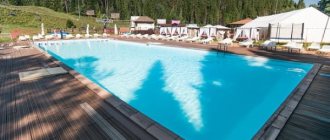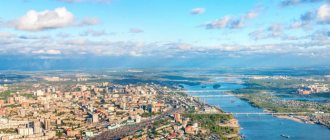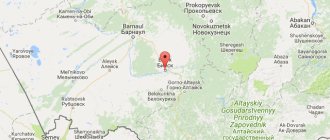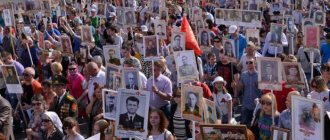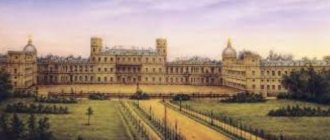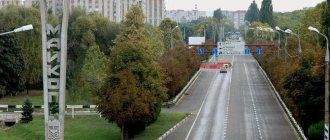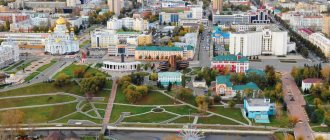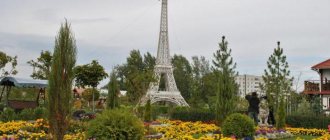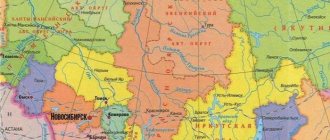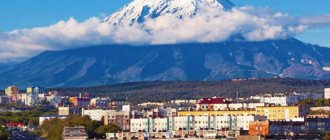For other places with the same name, see Chulym (populated area).
City in Novosibirsk region, Russia
| Chulym Chulym | |
| City [1] | |
| Railway station in Chulym | |
| Location of Chulym | |
| Chulym Location of Chulym Show map of Russia Chulym Chulym (Novosibirsk region) Show map of Novosibirsk region | |
| Coordinates: 55°07'N 80°58'E / 55.117°N 80.967°E / 55.117; 80.967 Coordinates: 55°07'N 80°58'E. / 55.117°N 80.967°E / 55.117; 80,967 | |
| A country | Russia |
| Federal subject | Novosibirsk region [1] |
| Administrative region | Chulymsky district [1] |
| Town | Chulym [2] |
| Based | 1762 |
| City status from | 1947 |
| Height | 130 m (430 ft) |
| population size (2010 Census) [3] | |
| • General | 11 568 |
| • Evaluate (2018) [4] | 11 216 ( −3% ) |
| Administrative status | |
| • Capital from | Chulym district [1], Chulym city [2] |
| Municipal status | |
| • Municipal district | Chulym municipal district [5] |
| • Urban village | Chulym urban settlement [5] |
| • Capital from | Chulym municipal district [6], urban settlement Chulym [5] |
| Timezone | UTC+7 (MSK+4[7]) |
| Postal code [8] | 632550–632553 |
| OKTMO ID | 50659101001 |
| Web site | www.admchulym.ru |
Chulym
(Russian: Chulym) is a city and the administrative center of Chulymsky District in Novosibirsk Oblast, Russia, located on the Chulym River 131 kilometers (81 mi) in Novosibirsk, the administrative center of the region.
Population: 11,568 people (according to the 2010 census); [3] 12,275 (2002 census); [9] 13,703 (1989 census). [10] Previously called Chulymskoe.
.
Content
- 1 Name of the competition 1.1 Nomination
- 4.1 My goal
Tributaries, regime
Many rivers and streams of the Krasnoyarsk Territory flow into Chulym. The most significant: right - Bolshoy Kemchuk, Uluy, Arba, Ulu-yul and Chichki-yul; left - Uryup, Seryozh, Bol. Roe deer, Itatskaya, Edet, Yaya and Kiya.
Chulym freezes at the end of October and opens at the beginning of May. At the Achinsk railway station there is a railway bridge across the river (an opening of 130 fathoms). In the spring, steamships with barges from Barnaul, Tyumen and Tomsk arrive in Achinsk. The flight from Tomsk to Achinsk lasts 10 days, in the opposite direction – 3 days. Navigation on the river in summer is negligible - steamships can only sail on the lower 1,173 kilometers.
Chulym. Guide
My goal
I want to write about my “Small Motherland”, delve into its past, talk about its historical beginning and subsequent development. Like many small towns in Russia, modern Chulym is experiencing many problems. The city's population is declining, and some manufacturing enterprises have ceased to exist. Over time, the appearance of the city has changed. However, Chulym is attractive in its own way, it has its own history and its own destiny. I believe that every person should love his land, the place where he was born. Be it a big city or a small village on the edge of a river.
I looked for materials with great interest and did a lot of work. I spoke with S.P.'s widow. Melnikova, T.G. Melnikova. I talked with the director of the music school Vasilyeva Lyudmila Yakovlevna about the cultural and spiritual life of the city of Chulym. I took materials from the regional statistics department. Worked with materials that were presented in the Chulym regional library. I used the handwritten texts of Sergei Pavlovich Melnikov, speaking about the past of the city of Chulym and about Chulym in the 20th century. He worked from a book about the emergence of settlements near the Moscow Highway: “Moscow Highway and Its Residents” by O.N. Cations.
The goal of my work is to introduce the city of Chulym to those people who are still unfamiliar with it. Tell about the nature of the region, the population and interesting people. Reveal the cultural and spiritual life of the city. Tell about the traditions that are preserved and observed by the residents of this city.
Chulym is one of the many small cities of Great Russia, which is unique in its own way. I think that the reader will see this originality and will pay attention to the talented people with whom the Chulym land is rich.
History of the city of Chulym
The emergence and development of the city of Chulym is connected with the West Siberian Railway. The settlements Itkul and (old Chulym) arose in connection with the construction of the Moscow Highway. In 1784, the Russian population of Baraba was part of the Tara district. Baraboo was predominantly populated by exiled peasants. In the village of Itkulsky in 1790 there was Torzhok, where products of peasant household industry and agricultural products were sold. The village of Itkul in the Chulym region and the village of Chulymskaya arose in the second half of the 18th century. They were founded by schismatic residents of the former “Polish branch”, devastated by the orders of Catherine II. Fugitive schismatics, hiding on the outskirts of Poland, were brought to Russia and exiled to Siberia. Here, some of them were left to build the Moscow Highway, and the majority were sent to work at the Kolyvano-Voskresensky factories. A record was made about Itkul in 1772, which has survived to this day: “The population of Itkul parish consists entirely of exiles. There are 1,500 males and 1,104 females here with their young children.” There were 2 churches in Itkul: the old one serving former schismatics and the new one for exiled serfs - “settlers.” (Minenko A.N. “Along the Old Moscow Highway.” P. 38)
The village of Chulymskaya, like the village of Itkul, arose in connection with the construction of the Siberian Highway. The newly built Kolyvano-Voznesensk plants also required the necessary means of communication, especially the highway, to connect with the European part of the country. The first Russian settlements on the territory of the Chulym region appeared along the highway. This is the village of Itkul and the village of Chulymskaya (old Chulym). The population of these villages was engaged in servicing the highway, transporting goods, and driving as a coachman, farming, hunting, and fishing. In the second half of the 18th century, the resettlement village of Romanovskoye appeared near the Chulym River. In 1893, a Chulymsky crossing was built among the swampy terrain, which later turned into the Chulymskaya station. Before the October Revolution, the village of Romanovskoye had 600 households, several small private enterprises - bakeries, a horse-drawn cheese factory, handicraft workshops. Activists who supported the Bolsheviks took the most active part in the Council - this was Ivan Semyonovich Vishnyakov, a water pump operator, he was the deputy chairman of the Council.
Ivan Kharitonov is the first leader of the Chulym Komsomol members. Our fellow countrymen defended the city with arms in hand during the civil war, hundreds of faithful sons laid down their heads in battle.
In 1932, at the insistence of the public, the village of Romanovskoye was renamed the village of Chulym. From the very beginning of its existence, the railway station was called Chulymskaya station. In 1937, Chulym became a working village, and in 1947 a city. One of the honorary residents of the city of Chulym, Sergei Pavlovich Melnikov, said: “In 1934, I came to the village of Chulym for the first time. I remember well how carts carrying the products of the Starochulym creamery passed along Kooperativnaya Street with great difficulty, carrying ice cream, cottage cheese, milk, and cheese to the retail chain. The wheels of carts drawn by horses or oxen sank up to the hubs, and the horses got stuck knee-deep in the mud. Chulymskaya Street was full of potholes and potholes. Pedestrians were helped by the few boardwalks laid on several streets in the center of the working-class village; remote streets did not have sidewalks. But the houses on the first street, now Sibirskaya, looked very beautiful. These were production and office premises. On the streets of Bankovskaya (now Rabochaya) and Kooperativnaya, the houses covered with iron made a pleasant impression on me. Of course, it took time to improve the city and facilities. And people had a desire. But the war broke out, and many plans were pushed into the background.” (Manuscript by Sergei Pavlovich Melnikov). Before the revolution, there were 600 residential buildings in the village of Romanovskoye. Before and after the war, private housing made of wattle and clay prevailed in Chulym. Now the district center has many cultural institutions and administrative buildings, apartment buildings and modern shops are being built. The issue of water supply and gasification of the city is being resolved. The history of our small homeland has deep roots. The first settlers who came here cultivated this land with their labor and enriched it. We are the descendants of these people who lived in the distant past, and we should engage in creative, rather than destructive, activities. After all, nature is not what our ancestors left us as an inheritance, but what we borrowed from our descendants. We must protect, preserve, love and enrich our native land. Be proud of the work of your ancestors. ¬The color and peculiarity of the city were manifested in architectural buildings. In my hometown there is an architectural monument: a pumping station with a water tower, built in 1893 - 1896. The well-preserved industrial building is an interesting example of architecture from the late 19th to early 20th centuries.
The building is valuable as an example of the first production buildings built for the needs of the Great Siberian Railway.
The author and builder are unknown. The pumping station with a water tower is located on the territory of the Chulym station. With its northern façade, the building is located parallel to the railway track. A special feature of the architectural composition is the asymmetrical layout of a large industrial building, which has the shape of an elongated rectangle and a low single-tier octagonal tower, connected by a narrow passage. The water tower was built according to a standard design developed directly for the West Siberian section of the Great Siberian Railway. The location of the pumping station on the territory of the railway station indicates that water is drawn from the well by vertical pumps driven by a steam engine.
The railway junction of the Chulymskaya station was developed during the Soviet five-year plans, especially after the war. In 1935, a car repair point (WRP) was created. And in 1952-1953, steam locomotives were replaced by powerful electric locomotives. 110 pairs of trains passed through Chulymskaya per day, this is the busiest section of ZapSib. In 1969, the reconstruction of the Chulym railway station was carried out.
Nature of the region
The nature of the region where the Chulymsky district is located has its own characteristics. The territory of the region, stretching from north to south, intersects two subzones - subtaiga and northern forest-steppe, which affects the average annual air temperature, which varies over the area from -0.9 to -0.1. The average temperature in July is +17-18 degrees, in January 19-20 degrees. Annual precipitation is 420 mm in the north, 350 in the south. Frosts begin on September 5-13 and end in the last ten days of May.
The territory of the region is a weakly dissected ridge plain, complicated by ancient drainage hollows. Low ridges rise above the interridge depressions by 4-10 m. In the north, the ridges are barely visible. The depressions between the ridges are occupied by small lakes and are often swampy.
The northern part, which belongs to the forest zone, is characterized by the predominance of aspen-birch grass forests and birch-sedge-hypnum bogs on the watersheds.
In the swamp belt there is a complex vegetation of solonetz-salt-marsh and swamp-salt-salt meadows (with wheatgrass, fresh fescue, barley and sedges).
Around the lakes there are reed fields or birch hummocks, turning into “ryams”. In numerous depressions there are sedge bogs surrounded by thickets of willow trees.
The forest cover of the region is very heterogeneous. The total forest area is 348 thousand. hectares, including forest - 243.4. Forest cover in the northern part exceeds 55%, in the south - a little more than 10%, the average for the region is 28.1%. In natural plantings, birch makes up 78.3%, aspen - 18.2%, pine - 3.3%, bush willows - 0.2%.
The northern part is characterized by typical forest inhabitants: elk, which has pronounced migrations, bear, lynx, wolverine, and various mustelids. In the southern part, foxes, weasels, and white hare are common, inhabiting deciduous forests and bush thickets; the brown hare, acclimatized in the 50s, is also noted. The ermine is numerous, as elsewhere in the Barabinsk forest-steppe, which from ancient times was famous as an ermine. In the northern and central parts of the region, where there are lakes and swamps, most species of waterfowl, waders, coots, and gray cranes are found. Black grouse and white partridge are common throughout the territory; in the north, in addition, hazel grouse are common, and capercaillie are less common.
Traditions
My city has its own holiday - birthday. August 19, 1947 is the birthday of Chulym, it was given the status of a city. For a city the period is short, but for its inhabitants it is an entire era. Over the years, several generations of our glorious fellow countrymen have changed. I probably won’t be mistaken if I say that this day is not just a holiday, a day of rest and entertainment. This is also a reason for realizing oneself as a citizen. The memory of those people who at different times built what we have now. The memory of those who created the social and cultural image of the city drove its technical progress. Everything is learned over the years, time allows you to see how the appearance of the city has changed, how enterprises appeared and how much they grew in their time, how much people and their spiritual world have changed.
I would really like to insert the words of Sergei Pavlovich Melnikov dedicated to Chulym: “My dear city. Modest, small. But dear, familiar, close.
Wherever each of us is, we always mentally return to its less than ideal streets. To its sunsets and sunrises, its beloved birches, spreading poplars, and a small river. But we feel especially acutely how dear he is to us when we return home after a separation, even a short one, when, around the last turn of the road, a small town with a non-Russian, but so painfully familiar name, Chulym, opens up to our eyes.” Victory Day is celebrated throughout the country on May 9. This is also a traditional holiday in our city.
On this day, veterans of the Great Patriotic War are honored in the main square of the city. In a solemn atmosphere, flowers are laid at the monument to the fallen heroes. For veterans, the workers of the cultural center organize a festive concert. The main goal of this event is the patriotic education of the younger generation in the spirit of love for the Motherland and respect for war veterans who bore burdens and hardships on their shoulders and allowed today's Russia to be independent and free.
Despite the problems, residents of the city of Chulym continue to play sports. In our city there are people who actively help and promote the development of sports. Our city will continue sports traditions and give new records to the area.
The tradition of schoolchildren is a trip with teachers to the countryside, traditional school events.
Traditional folk holidays are the farewell to the Russian winter, the city day.
Environmental marathons and conferences are held regularly. All schoolchildren are trying to understand and explain the cause of environmental pollution. It is necessary to attract public attention to the positive experience of forming a spiritual environment, the formation of a New Man to solve local environmental problems in our city
Cultural and spiritual life of the city
The cultural and spiritual life of our city has its own development. We have a music school, two cultural centers, and a sports complex.
We are creating creative teams that can defend the honor of the city at the regional level. We have heads of enterprises and organizations who try to maintain the culture as best they can.
Young chess players in our region traditionally open the chess season with team competitions.
For their great contribution to the economic, social and cultural development of the city, residents may be awarded the title “Honorary Resident of the City of Chulym.”
On August 26, 1957, by decision of the executive committee of the Chulym District Council of Deputies, a music school was opened. In 1978, an assembly hall was added. Over the years, 396 graduates have been graduated. 44 graduates entered higher education institutions, many of them now work in Chulym kindergartens and schools. The contingent is about 100, now 150. Of the 14 teachers, 12 are graduates of this school. Children learn to play the piano, button accordion, accordion, dombra, balalaika and guitar. Kolesnikova Ekaterina Vyacheslavovna plays the guitar and teaches this skill to our younger generation. Thanks to her, we hold rock festivals in Chulym, in which our youth participate. Currently, 3 rock groups have been created. Music school teachers believe that the main thing is that there is mutual understanding and respect between the student and the teacher.
The SERDALIK theater was created in Chulym, which means heart and face. About 25 performances have already been staged. The team consists of 10 people. The theater went to Kuibyshev for a festival, where they received a diploma.
Chulym and its inhabitants
Vasilyeva Lyudmila Yakovlevna was born in Moscow. Then she lived in Novosibirsk for 18 years. I didn’t come to music right away; first I studied at a construction school, then I graduated from the Novosibirsk Conservatory. She came to Chulym in 1972. Before that, she worked in Karasuk at a music school. She worked as a teacher at a music school in Chulym for 13 years, and now works as a director. Lyudmila Yakovlevna is one of the theater participants. A faithful person in friendship. Doesn't like humiliation. Her motto: “We are all responsible for those we have tamed.” He doesn’t regret living in Chulym; he likes the friendly and familiar atmosphere. She believes that in a small town, you can become an individual, which is what she achieved.
Sergei Pavlovich Melnikov was born on August 19, 1926. In the village of Sarokomyshka, Chulym region, in a large peasant family. The family was large and friendly, 12 people: father, mother and 10 children. In the village I finished 7 classes. Some of the sisters and brothers left for Alma-Ata, some died.
On June 22, 1941, they moved to live in Chulym. When they entered the new house, a neighbor immediately ran up to them on Kooperativnaya Street and said that the war had begun. His older sister Polina went to the front, and Sergei Pavlovich himself began working at a defense plant as a teenager. After the end of the war, he went to study at a pedagogical school. Worked at school. In 1951, he switched to Komsomol work and was elected secretary of the Nodal Committee of the Komsomol of the Chulym Republic of the Komsomol
For many years he worked in the Soviet and party bodies of the region. In 1985, he was appointed director of the Chulym district sales office, from where he retired.
Sergei Pavlovich was distinguished by such qualities as responsibility, decency, responsiveness, kindness, sensitivity, and conscientious attitude towards the assigned work. Over the many years of his working life, he met and worked with many people, helping them with advice and deeds, and actively participated in the public life of the area.
A born leader, he had a clear position in life and had the ability to convince people and lead them. Unfortunately, Sergei Pavlovich passed away. The bright memory of Sergei Pavlovich will always live in our hearts. Fyodor Akimovich Maydanyuk was born into the family of a carpenter.
The tree has always been a friend to him. And the ability to distinguish between tree species was probably already in his blood. Since childhood, he knows the benefits each tree brings to humans.
I started doing wooden sculpture somehow suddenly. He constantly noticed even in the most, to the simplest human eye, ugly piece of driftwood, something unusual, extraordinary.
For more than twenty years, Fyodor Maydanyuk has been engaged in artistic woodworking, making sculptural items in the form of souvenirs and subject compositions.
He and his works are known not only here in Siberia, but also in America, Holland, Germany, and Switzerland.
Chulym modern
Currently, new residential buildings are being built in Chulym. In recent years, institutions important for the social and cultural life of the townspeople have been built: a district hospital, a sports complex and a veterans' home.
The traditions of social activity are adopted by younger generations, giving birth to new interesting endeavors, such as the “Literary Lounge” and amateur theater.
Recently, the Youth Club, which was located in the building of the former railway workers’ club, and the House of Children’s Creativity, which also occupies a large room, beautifully decorated by designers, have begun to play a large role in the organization of youth.
The following enterprises operate stably: a butter and cheese plant, a grain receiving enterprise, inter-district energy enterprises, one of the best telecommunications centers in the region, track distance and track repair and mechanical workshops, and motor transport enterprises.
More and more private enterprises are opening. Today, about 650 people are employed in the small business sector. Transformations are taking place in the housing and communal services sector. Roads are improving. It is planned to build a water purification station. To achieve these goals, great concerted efforts will be required on the part of all city residents.
Conclusion
- Chulym people love their land. No wonder so many poets are born here. Their poems have already twice migrated from the regional newspaper to poetry collections. Chulym is famous for its folk craftsmen, artists, passionate and creative people.
- The emergence and development of Chulym is inextricably linked with the construction of the Moscow Highway and the West Siberian Railway.
- The traditions of Chulym are special, so they are preserved and passed on from generation to generation.
- The city administration and business leaders need to create prestigious jobs so that the population increases.
This Guide can be used during excursions, in lessons on the history of Siberia and local history, placed in school libraries and used as local history material.
Hydrology
The average long-term water flow in the lower reaches of the river is 785 m3/s (flow is 24.775 cubic kilometers per year). The predominant food supply of the reservoir is snow. The water regime of the river is the West Siberian type with spring-summer floods. The highest water flow is 8220 m3/s, the smallest is 108 m3/s.
With an average annual turbidity of 0.086 kg per 1 cubic meter. meter, the suspended sediment flow is 68 kg/s, and the suspended sediment flow is 2,100 thousand tons per year. The Chulym River freezes, as noted above, in early November, and opens until the beginning of May. Congestion often occurs here, which contributes to a rise in water levels of up to 10 meters. The ice reaches a thickness of up to one meter.
The river waters are hydrocarbonate in their chemical composition and belong to the calcium group. Its mineralization along the entire length of the river reaches 190-400 milligrams per liter.
